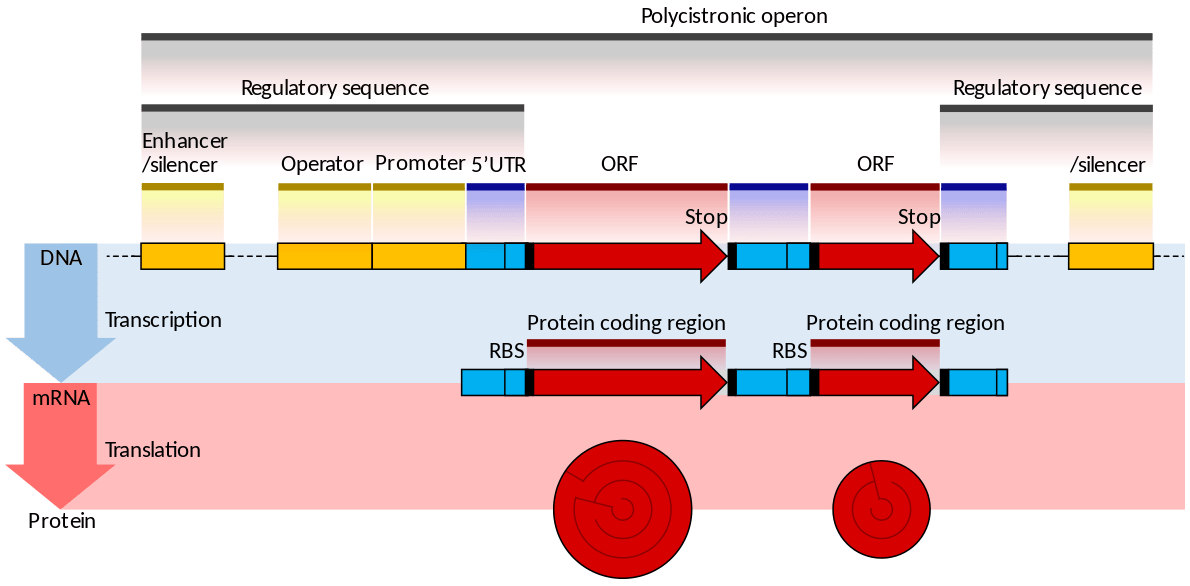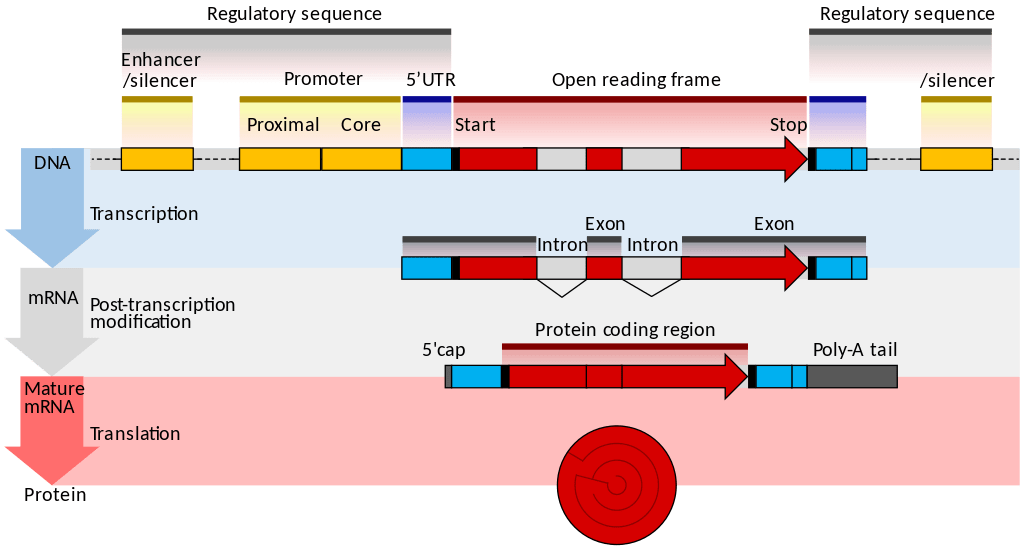Difference Between Prokaryotic and Eukaryotic mRNA
Key Difference – Prokaryotic vs Eukaryotic mRNA
mRNA is referred to as messenger ribonucleic acid which encodes for different proteins. Transcription is the process in which a mRNA molecule is formed from a DNA template. The transcribed mRNA molecule possesses all the codes that are required to produce a protein with the help of ribosomes. The mechanisms which form mRNA through transcription and proteins through translation differ according to the type of organisms. In prokaryotes in between the transcription, the mRNA can enter the translation process and undergoes less transcriptional modifications while in eukaryotes, the transcribed mRNA undergoes heavy transcriptional modification process and enters into the cytoplasm for translation. The key difference between Prokaryotic and Eukaryotic mRNA is that prokaryotic mRNA is polycistronic while eukaryotic mRNA is monocistronic.
CONTENTS
1. Overview and Key Difference
2. What is Prokaryotic mRNA
3. What is Eukaryotic mRNA
4. Similarities Between Prokaryotic and Eukaryotic mRNA
5. Side by Side Comparison – Prokaryotic vs Eukaryotic mRNA in Tabular Form
6. Summary
What is Prokaryotic mRNA?
The prokaryotic gene transcription process forms the prokaryotic mRNA. It is not a sophisticated molecule when compared with eukaryotic mRNA. In bacterial transcription, the genetic information stored in DNA is transcribed into mRNA transcripts which then could be coded for proteins through the bacterial translation process. Prokaryotic mRNA are polygenic. This means a single prokaryotic mRNA is formed through transcription with the involvement of operons that consist of many structural genes. Therefore, they are known as polycistronic mRNA.
The prokaryotic mRNA consists of many sites for both codons initiation and termination. This proves the fact that, a single prokaryotic mRNA molecule could give rise to different types of prokaryotic proteins. While the mRNA is transcribed, it can directly undergo translation. Therefore, in bacteria, translation and transcription occur simultaneously at the same place. In prokaryotes, sufficient post-transcriptional modifications do not occur in the transcribed mRNA molecule. This is because the presence of a short period between transcription and translation as mentioned above. Comparatively, prokaryotic mRNA has a shorter lifespan when compared with eukaryotic mRNA.

The prokaryotic mRNA is degraded through a series of reactions with the involvement of a combination of enzymes known as ribonucleases. These ribonucleases include 3’ exonucleases, 5’ exonucleases and endonucleases. Small RNA (sRNA) has the potential to degrade mRNA. sRNA is composed if many nucleotides that could be utilized to initiate the degradation of mRNA through complementary base pairing. Once paired, ribonuclease cleavage is facilitated through RNase III which results in mRNA degradation.
What is Eukaryotic mRNA?
Eukaryotic mRNA is transcribed from a DNA template inside the nucleus. In eukaryotes, transcription and translation occur in two different places. In prokaryotes, both processes occur in one place. Once eukaryotic mRNA is produced within the nucleus, it is transported into the cytoplasm for translation. After transcription, mRNA molecule undergoes post-transcriptional modifications before transporting into the cytoplasm. After entering into the cytoplasm, mRNA molecule gets united with ribosomes through different complexes become ready for translation.
Unlike in prokaryotes, eukaryotic translation only begins when the transcriptional process is fully completed. In the context of eukaryotic mRNA structure, it consists only one site of initiation and one site of protein synthesis termination. Therefore they are referred to as monocistronic mRNA. But once transcribed, the mRNA which is known as the pre mRNA transcript undergoes a series of post-transcriptional modifications.
These modifications include, the addition of a poly A tail, adenylation at the 3’ end etc. The poly A tails makes the mRNA molecule is more stable. At the 5’ end, the formation of a cap with the help of guanylate residues occur. This protects the mRNA from degradation. mRNA splicing is another modification that takes place in the pre mRNA transcript. The whole mRNA consists of both coding and non coding regions known as exons and introns respectively. Through splicing, the non coding regions are removed from the transcript leaving only coding regions.

In the context of eukaryotic mRNA life span, they have a longer life span compared to prokaryotic mRNA. This is due to the fact that, eukaryotic mRNA is much metabolically stable than prokaryotic mRNA.
What is the Similarity Between Prokaryotic and Eukaryotic mRNA?
- Both code for proteins.
What is the Difference Between Prokaryotic and Eukaryotic mRNA?
Prokaryotic vs Eukaryotic mRNA | |
| Prokaryotic mRNA is the RNA molecule which codes for prokaryotic proteins. | Eukaryotic mRNA is the RNA molecule which encodes for eukaryotic proteins. |
| Type | |
| Prokaryotic mRNA is polycistronic. | Eukaryotic mRNA is monocistronic. |
| Lifespan | |
| Prokaryotic mRNA has a shorter lifespan. | Eukaryotic mRNA has a comparatively a long lifespan. |
| Post Transcriptional Modifications | |
| Post transcriptional modifications are absent in Prokaryotic mRNA. | Post transcriptional modifications are present in eukaryotic mRNA |
Summary – Prokaryotic vs Eukaryotic mRNA
Prokaryotic mRNA are polygenic. They consist of many sites for both codons initiation and termination. A single prokaryotic mRNA molecule could give rise to different types of prokaryotic proteins. Transcription and translation processes happen simultaneously in prokaryotes. Prokaryotic mRNA has a shorter lifespan. They are prone to be degraded through a series of reactions with the involvement of a combination of enzymes. Significant post-transcriptional modifications are not common in prokaryotic mRNA. Unlike in prokaryotes, eukaryotic translation only begins when the transcriptional process is fully completed. Eukaryotic mRNA is monogenic. One mRNA molecule results in only a single protein. Eukaryotic mRNA undergoes a series of modifications such as polyadenylation, 5’ capping and splicing etc. And also eukaryotic mRNA has a longer lifespan due to the mRNA stability. This is the difference between prokaryotic and eukaryotic mRNA.
Download the PDF Version of Prokaryotic vs Eukaryotic mRNA
You can download PDF version of this article and use it for offline purposes as per citation note. Please download PDF version here Difference Between Prokaryotic and Eukaryotic mRNA
Reference:
1.Parker, J. “Polycistronic mRNA.” Encyclopedia of Genetics, 2001, p. 1496., doi:10.1006/rwgn.2001.1008.
2.“Eukaryotic pre-mRNA processing (Article).” Khan Academy. Available here
Image Courtesy:
1.’Gene structure prokaryote 2 annotated’By Thomas Shafee – Shafee T, Lowe R (2017). “Eukaryotic and prokaryotic gene structure”. WikiJournal of Medicine 4 (1). DOI:10.15347/wjm/2017.002. ISSN 20024436., (CC BY 4.0) via Commons Wikimedia
2.’Gene structure eukaryote 2 annotated’By Thomas Shafee – Shafee T, Lowe R (2017). “Eukaryotic and prokaryotic gene structure”. WikiJournal of Medicine 4 (1). DOI:10.15347/wjm/2017.002. ISSN 20024436., (CC BY 4.0) via Commons Wikimedia
ncG1vNJzZmivp6x7pbXFn5yrnZ6YsqOx07CcnqZemLyue8OinZ%2Bdopq7pLGMm5ytr5Wau2680aiimqqppMGqr4yapZ1lpqh6psHKmqmyp6SesG650aeYaA%3D%3D